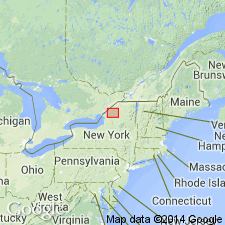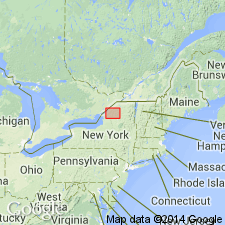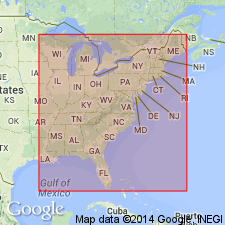
- Usage in publication:
-
- Hyde School Gneiss
- Modifications:
-
- Named
- Dominant lithology:
-
- Gneiss
- Alaskite
- Tonalite
- AAPG geologic province:
-
- Adirondack uplift
Summary:
Hyde School Gneiss, first used by Carl (1988: GSA Bull., v. 100, no. 6, p. 842), is here given formal formational status. Unit occurs as 13 bodies of massive, pink alaskitic gneisses and plagioclase-rich gneisses in multiply folded domes scattered throughout the lowlands of the northwest Adirondacks of NY. Name is from best exposed and most studied body at site of Hyde School [ruins] in Pope Mills quad. Unit also includes (from west to east) Dodds Creek, Payne Lake, Gouverneur, Fish Creek, Hickory Lake, Reservoir Hill, California, Clark Pond, Canton, South Pyrites, Stalbird and North Pyrites bodies. Unit has been previously mapped (in part) as Alexandria Bay Gneiss (here abandoned) by Wiener and others (1984) and as lower gneiss by Lewis (1969: Syracuse Univ. Ph.D. thesis). Thickness is estimated at 500 m and an ash-flow tuff protolith is proposed. Hyde School Gneiss is Middle Proterozoic based on a U-Pb age of 1284+/- recorded by McLelland and others (1988: GSA Geology, v. 16, p. 920). Authors of this report urge the abandonment of the five formations and two groups proposed by Wiener and others (1984) and propose a column of four formations based on Lewis (1969) which includes ascending Hyde School Gneiss (also called Hyde School Gneiss Formation), lower marble, Popple Hill Gneiss (was Poplar Hill) and upper marble.
Source: GNU records (USGS DDS-6; Reston GNULEX).

- Usage in publication:
-
- Hyde School Gneiss
- Modifications:
-
- Overview
- AAPG geologic province:
-
- Adirondack uplift
Summary:
Alaskitic and tonalitic rocks composing the Hyde School Gneiss occur in 14 dome-shaped bodies in the Adirondack lowlands. Though previously interpreted as metamorphosed rhyolite and dacitic ash-flow deposits at the base of a regional stratigraphic package, these authors present evidence that the Hyde School has an intrusive origin. U-Pb zircon ages indicate the intrusion at 1230+/-33 Ma.
Source: GNU records (USGS DDS-6; Reston GNULEX).

- Usage in publication:
-
- Hyde School Gneiss
- Modifications:
-
- Geochronologic dating
- AAPG geologic province:
-
- Adirondack uplift
Summary:
U-Pb zircon ages for Hyde School Gneiss indicate that it crystallized around 1285 to 1230 Ma. U-Pb zircon ages for lithologically similar Lyon Mountain Gneiss indicate crystallization around 1080 to 1050 Ma. Despite similar appearances, the two gneisses are of a different origin. [Information is from section by J. McLelland and others within Chapter 5.]
Source: GNU records (USGS DDS-6; Reston GNULEX).
For more information, please contact Nancy Stamm, Geologic Names Committee Secretary.
Asterisk (*) indicates published by U.S. Geological Survey authors.
"No current usage" (†) implies that a name has been abandoned or has fallen into disuse. Former usage and, if known, replacement name given in parentheses ( ).
Slash (/) indicates name conflicts with nomenclatural guidelines (CSN, 1933; ACSN, 1961, 1970; NACSN, 1983, 2005, 2021). May be explained within brackets ([ ]).

